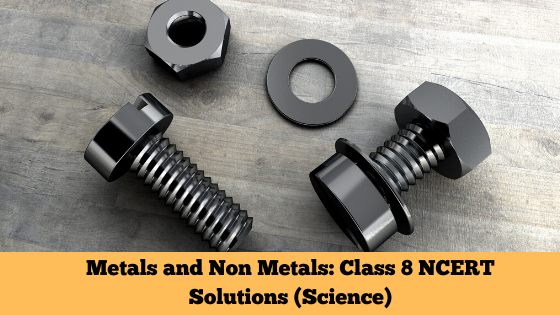
Class 8 Science NCERT Solutions
Metals and non Metals is an important chapter in Class 8. NCERT Science book explains the chapter in a detailed manner and presents a lot of examples to the students so that they can understand the concepts well. Are you in class 8 and looking for NCERT Solutions for Chapter Metals and Non-metals. Below we have shared the NCERT Solutions for Chapter 4 of Class 8 Science book. You can also download Metals and Non Metals NCERT solutions PDF for free.
Question 1: Which of the following can be beaten into thin sheets?
(a) Zinc (b) Phosphorus (c) Sulphur (d) Oxygen
Ans: (a) zinc
Question 2: Which of the following statements is correct?
(a) All metals are ductile
(b) All non-metals are ductile
(c) Generally, metals are ductile
(d) Some non-metals are ductile
Ans: (c) Generally, metals are ductile
Well, the exception exists. For ex. Mercury is metal but remains in a liquid state at room temperature and hence is not ductile
Question 3: Fill in the blanks:
(a) Phosphorus is a very ——– nonmetal
(b) Metals are_____ conductors of heat and _____
(c) Iron is _____ reactive than copper
(d) Metals react with acids to produce _____ gas.
Ans:
(a) reactive
(b) good | electricity
(c) more
(d) hydrogen
Materials and Non Metals Class 8 Ch4: Complete Explanation by Deepak Sir
Question 4: Mark T if the statement is true and mark F if the statement is not true
Ans 4:
(a) Generally, non-metals react with acids
(b) Sodium is a very reactive metal
(c) Copper displaces zinc from zinc sulphate solution
(d) Coal can be drawn into thin wires
Ans:
(a) False
(b) True
(c) False
(d) False
Question 5: Some properties are listed in the following table. Distinguish between metals and non-metals on the basis of these properties
| Properties | Metals | Non metals |
|---|---|---|
| Appearance | Lustrous | Dull |
| Hardness | Are generally hard | Soft in composition |
| Malleability | Can easily be drawn into thin sheets | Non metals can not be drawn into thin sheets |
| Ductility | Ductile: Can be drawn into wires | Can not be drawn into wires |
| heat conduction | Good conductors of heat | Are generally poor conductors of heat |
| Conduction of electricity | Good conductors of electricity | Bad conductors of electricity |
(a) Aluminium foils are used to wrap items
Aluminium foils are used for wrapping food because it is malleable and can be drawn into thin sheets, basically foils. Aluminium foil keeps the food warm for a long time.
(b) Immersion rods for heating liquids are made up of metallic substances
Ans (b): Metals are good conductors of both heat and electricity. so, metals are used in making the immersion rods so they can easily conduct heat and electricity.
(c) Copper cannot displace zinc from its salt solution
Copper can not displace zinc from Zinc sulphate because zinc is more reactive than copper. To displace another element the metal should be more reactive.
(d) Sodium and Potassium are stored in Kerosene
Sodium and Potassium metals are highly reactive metals. So, they are kept in a container containing Kerosene oil so that they do not react on coming in contact with the air.
Question 7: Can you store lemon pickle in aluminium utensils? Explain
Ans 7: No, we can not store lemon pickle in aluminium utensils because aluminium is a metal and it easily reacts with the acid present in lemon. When the acid will reach with the metal it will degrade the quality of the pickle and it will no longer be worth eating.
Question 8: Match the substances in Column A with their uses given in Column B
Question 9: What happens when:
(a) Dilute Sulphuric acid is poured on a Copper plate?
When we pour dilute sulphuric acid on a copper plate then hydrogen gas will be evolved. Copper will displace the hydrogen and CuSO4 will be formed.
Cu + H2SO4 (dil) —> CuSO4 + H2 (g)
(b) Iron nails are placed in the Copper Sulphate solution
Iron is more reactive than copper metal. So, when we put iron nails in Copper Sulphate Solution, iron will displace Copper and Copper Sulphate will be formed. Copper deposits can be easily noticed on the iron nails.
Let us check out the reaction for the same:-
Fe (s) + CuSO4 —> FeSO4 + Cu (s)
So, these were the Solutions for Class 8 Science Chapter, Metals and Non Metals. If you want Class 8 NCERT Solutions for more chapters of Maths and Science don’t forget to subscribe to our blog. We keep sharing solutions for various chapters. Don’t forget to subscribe for free Class 8 NCERT solutions PDF.
Download Class 8 Metals and Non Metals NCERT Solutions PDF

Leave a Reply